Discover 35 hidden attractions, cool sights, and unusual things to do in Bucharest (Romania). Don't miss out on these must-see attractions: Village Museum, Palace of the Parliament, and Cotroceni Palace. Also, be sure to include Palatul Mogoșoaia in your itinerary.
Below, you can find the list of the most amazing places you should visit in Bucharest (Bucharest).
Table of Contents
Village Museum
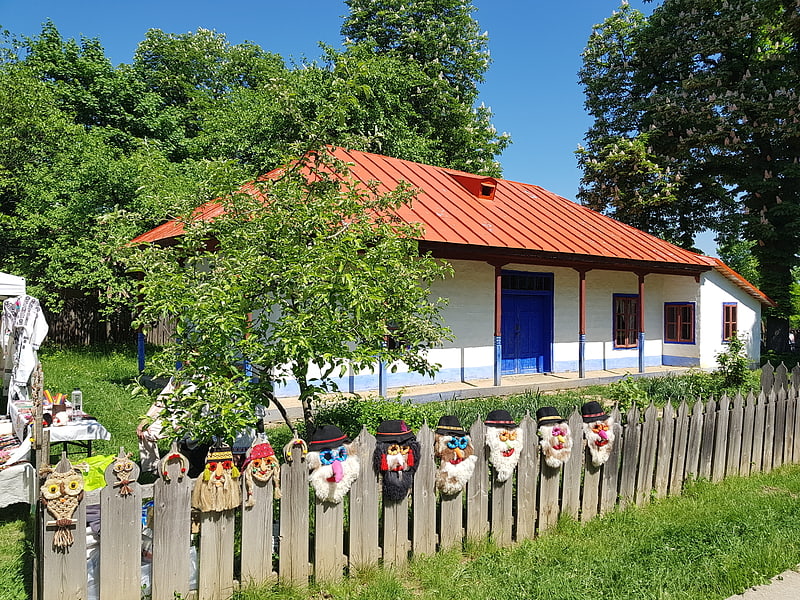
Also known as: Muzeul Național al Satului „Dimitrie Gusti”
Open-air museum of village life. The Village Museum formally National Museum of the Village "Dimitrie Gusti" is an open-air ethnographic museum located in the King Michael I Park, showcasing traditional Romanian village life. The museum extends to over 100,000 m2, and contains 272 authentic peasant farms and houses from all over Romania.
The village was a creation of the folklorist and sociologist Dimitrie Gusti. The location plans were executed by the writer, playwright, director Victor Ion Popa and set designer Henri H. Stahl. The necessary financial funds were provided by the Royal Cultural Foundation and in the presence of King Carol II of Romania the museum was inaugurated on May 10, 1936.[1]
Address: Șoseaua Pavel Dimitrievici Kiseleff, 011347 București (Sector 1)
Palace of the Parliament

Also known as: Palatul Parlamentului
Huge Communist palace, now parliament. The Palace of the Parliament, also known as the Republic's House or People's House/People's Palace, is the seat of the Parliament of Romania, located atop Dealul Spirii in Bucharest, the national capital. The Palace reaches a height of 84 metres, has a floor area of 365,000 square metres and a volume of 2,550,000 cubic metres. The Palace of the Parliament is the heaviest building in the world, weighing about 4,098,500,000 kilograms, also being the second largest administrative building in the world.
The building was designed and supervised by chief architect Anca Petrescu, with a team of approximately 700 architects, and constructed over a period of 13 years (1984–97) in Socialist realist and modernist Neoclassical architectural forms and styles, with socialist realism in mind. The Palace was ordered by Nicolae Ceaușescu (1918–1989), the president of Romania and the second of two long-ruling heads of state in the country since World War II, during a period in which the personality cult of political worship and adoration increased considerably for him and his family.
Known for its ornate interior composed of 23 sections, the palace houses the two chambers of the Parliament of Romania: the Senate (Senat) and the Chamber of Deputies (Camera Deputaților), along with three museums and an international conference center. The museums in the Palace are the National Museum of Contemporary Art, the Museum of Communist Totalitarianism (established in 2015) and the Museum of the Palace. Though originally named the House of the Republic when under construction (Romanian: Casa Republicii), the palace became widely known as The People's House (Romanian: Casa Poporului) after the Romanian Revolution of December 1989. Due to its impressive characteristics, events organized by state institutions and international bodies such as conferences and symposia take place there, but despite this about 70% of the building remains empty.
As of 2020, the Palace of the Parliament is valued at €4 billion, making it the most expensive administrative building in the world. The cost of heating, electricity, and lighting alone exceeds $6 million per year, comparable to the total cost of powering a medium-sized city.[2]
Address: Bucharest, Calea 13 Septembrie 1, Sector 5
Cotroceni Palace
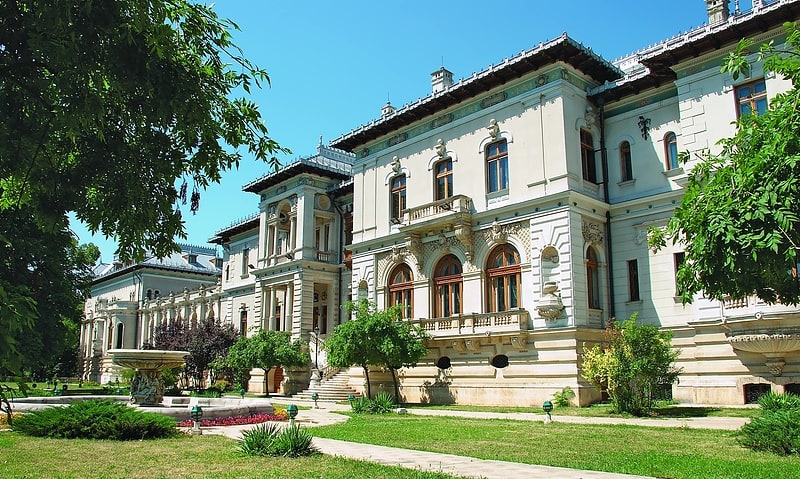
Also known as: Palatul Cotroceni
National museum in a baroque palace. Cotroceni Palace is the official residence of the President of Romania. It is located at Bulevardul Geniului, nr. 1, in Bucharest, Romania. The palace also houses the National Cotroceni Museum.[3]
Address: Bulevardul Geniului 1-3, 060116 București (Sector 5)
Palatul Mogoșoaia
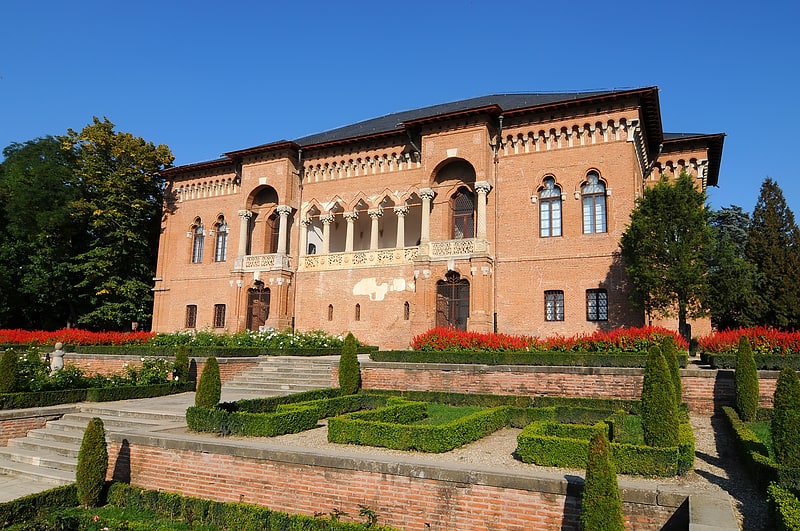
18th-century estate and public park. Mogoșoaia Palace is situated about 10 kilometres from Bucharest, Romania. It was built between 1698–1702 by Constantin Brâncoveanu in what is called the Romanian Renaissance style or Brâncovenesc style. The palace bears the name of the widow of the Romanian boyar Mogoș, who owned the land it was built on.[4]
Address: Strada Constantin Brâncoveanu, Bucharest
National Museum of Romanian History
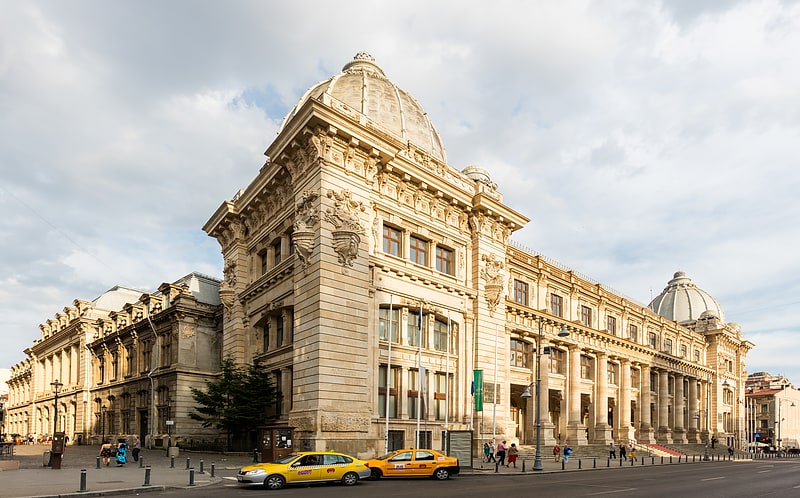
Also known as: Muzeul Național de Istorie a României
Roman artifacts and the national treasury. The National Museum of Romanian History is a museum located on the Calea Victoriei in Bucharest, Romania, which contains Romanian historical artifacts from prehistoric times up to modern times.
The museum is located inside the former Postal Services Palace, which also houses a philatelic museum. With a surface of over 8,000 square meters, the museum has approx. 60 valuable exhibition rooms. The permanent displays include a plaster cast of the entirety of Trajan's Column, the Romanian Crown Jewels, and the Pietroasele treasure.
The building was authorized, in 1892, and the architect, Alexandru Săvulescu was sent with the postal inspector, Ernest Sturza, to tour various postal facilities of Europe for the design. The final sketches were influenced primarily by the postal facility in Geneva. Built in an eclectic style, it is rectangular with a large porch on a high basement and three upper floors. The stone façade features a portico supported by 10 Doric columns and a platform consisting of 12 steps spanning the length of the building. There are many allegorical sculptural decorative details.
As of 2012, the museum is undergoing extensive restoration work and it is only partially open; a late medieval archaeological site was discovered under the building.[5]
Address: Calea Victoriei 12, 030026 București (Sector 3)
Bulevardul Magheru
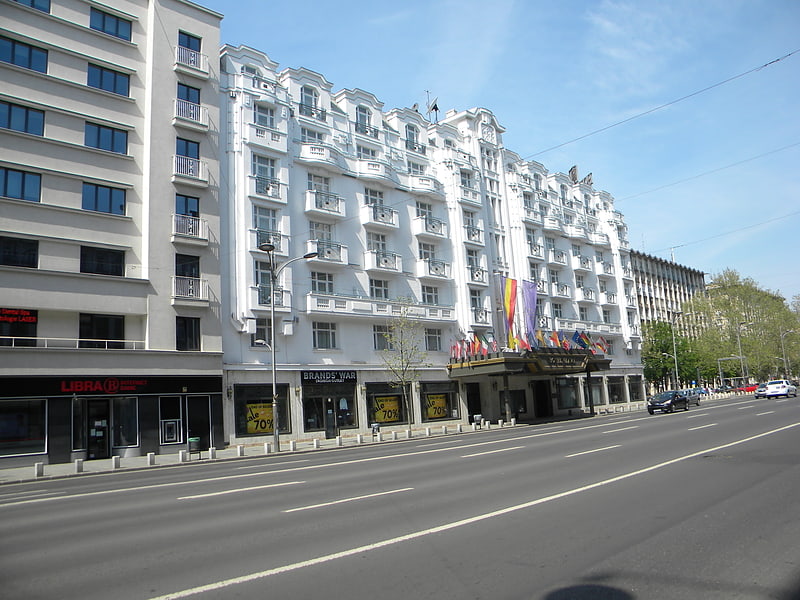
Also known as: Bulevardul Gheorghe Magheru
Street in Bucharest, Romania. Bulevardul Magheru is a major street in central Bucharest. Built in the early 20th century, it is named after General Gheorghe Magheru.
Together with Bulevardul Bălcescu, Magheru connects Piața Romană and Piața Universității squares and was in the 1930s and 1940s Bucharest's most modern part. This is one of Europe and world's most representative modernist boulevards, where the architecture in vogue in the 1930s is prevalent.
Part of the major thoroughfare than runs through the middle of Bucharest, it is continued to the south of C. A. Rosetti Street by Nicolae Bălcescu Boulevard and then by Ion C. Brătianu Boulevard, and toward the north by Lascăr Catargiu Boulevard and Șoseaua Kiseleff.
Bulevardul Magheru is one of the most expensive shopping streets in Europe.[6]
Bellu Cemetery
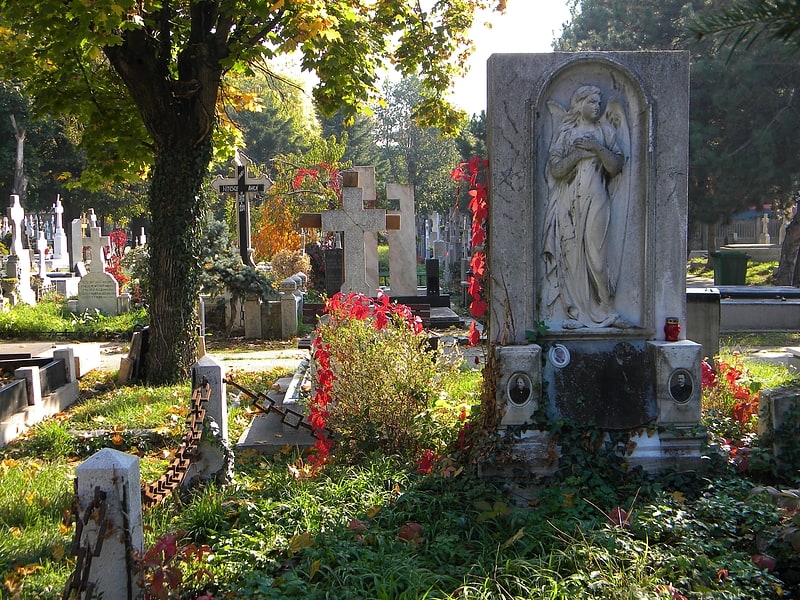
Also known as: Cimitirul Bellu
Historic cemetery with noted burials. Șerban Vodă Cemetery is the largest and most famous cemetery in Bucharest, Romania.
It is located on a plot of land donated to the local administration by Baron Barbu Bellu. It has been in use since 1858. The cemetery covers 54 acres and it is one of the most authentic cultural attractions in Bucharest.[7]
Address: Calea Serban Voda nr. 249, sector 4, Bucharest (Sector 4)
Elisabeta Palace
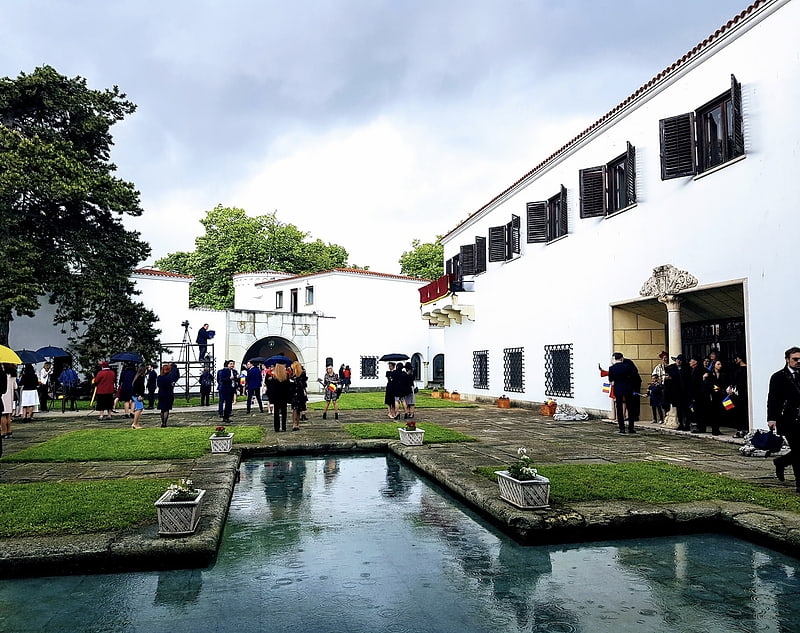
Also known as: Palatul Elisabeta
Palace in Bucharest, Romania. Elisabeta Palace is a palace on Kiseleff Road in Bucharest, Romania. Built in 1936, it is the official residence in Romania of Margareta of Romania, her husband Prince Radu, and her sister Princess Maria.
The Palace was designed in 1930 by the architect Duiliu Marcu and built in 1936 for Princess Elisabeth, the daughter of King Ferdinand I and his wife Queen Marie, and also the aunt of King Michael I, who was forced to abdicate on 30 December 1947.
In 2001, the Romanian Senate passed a bill which states that the Palace would be awarded to the former king for use as a residence during his lifetime. Since then, members of the former Royal Family have been living there. Foreign heads of state, royalty and politicians are received there, as well as Romanian political, cultural, economic and academic figures when special events are conducted.[8]
Address: 28 Șoseaua Pavel Dimitrievici Kiseleff, Bucharest (Sector 1)
CEC Palace
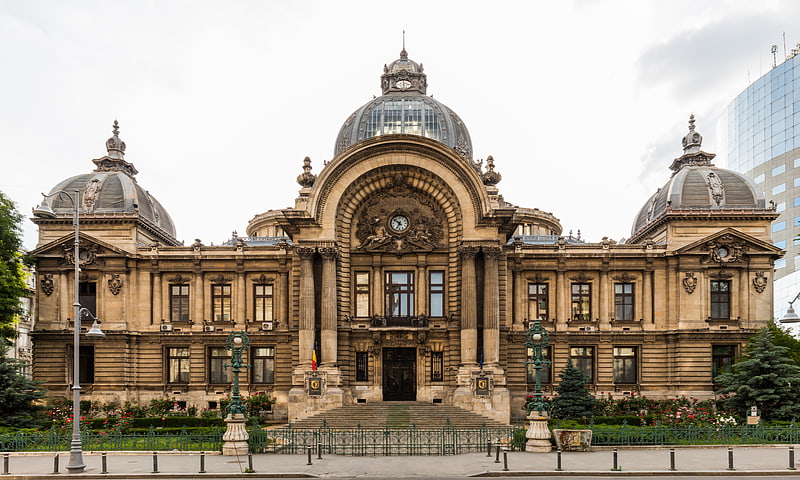
Also known as: Palatul CEC
Bank in Bucharest, Romania. The CEC Palace in Bucharest, Romania, built between 8 June 1897 and 1900, and situated on Calea Victoriei opposite the National Museum of Romanian History, is the headquarters of CEC Bank.[9]
Address: Calea Victoriei 13, 030022 Bucharest (Sector 5)
National Museum of Art of Romania
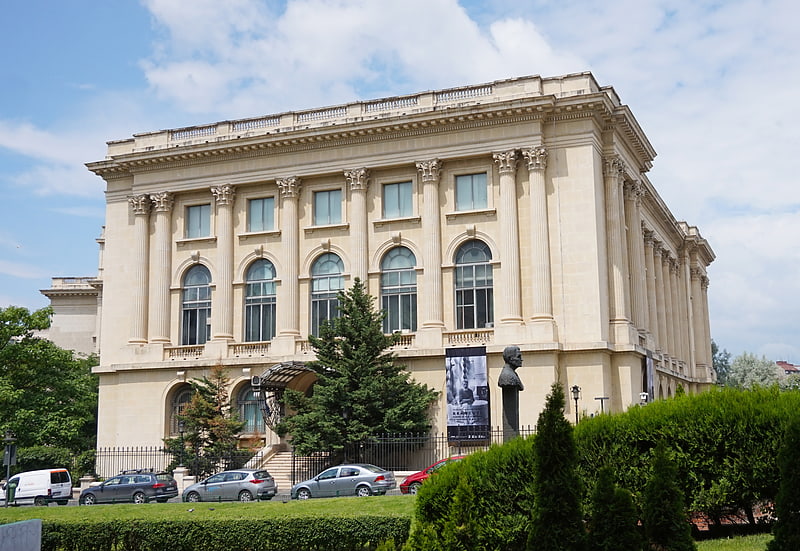
Also known as: Muzeul Național de Artă al României
Artworks from Romania, Europe and Asia. The National Museum of Art of Romania is located in the Royal Palace in Revolution Square, central Bucharest. It features collections of medieval and modern Romanian art, as well as the international collection assembled by the Romanian royal family.
The exhibition "Shadows and Light" ran from 15 July to 2 October 2005. With four centuries of French art, it was the largest exhibition of French painting in Central and Eastern Europe since 1945. 77 works were exhibited, including masterpieces by painters such as Poussin, Chardin, Ingres, David, Delacroix, Corot, Cézanne, Matisse, Picasso, and Braque.[10]
Address: Palatul Regal, 010082 București (Sector 1)
Ateneul Roman

Also known as: Ateneul Român
Neoclassical concert hall dating to 1888. The Romanian Athenaeum is a concert hall in the center of Bucharest, Romania and a landmark of the Romanian capital city. Opened in 1888, the ornate, domed, circular building is the city's most prestigious concert hall and home of the "George Enescu" Philharmonic and of the George Enescu Festival.[11]
Address: Bucharest, str. Franklin nr. 1-3, sector 1
National Military Museum
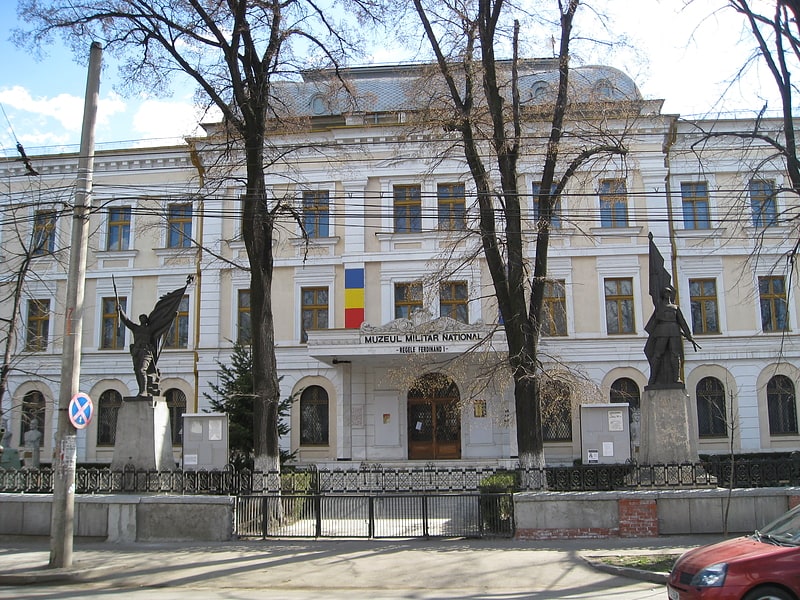
Also known as: Muzeul Militar Național
Military models and weapons from many eras. The King Ferdinand I National Military Museum, located at 125-127 Mircea Vulcănescu St. Bucharest, Romania, was established on 18 December 1923 by King Ferdinand I. It has been at its present site since 1988, in a building finished in 1998.[12]
Address: Str. Mircea Vulcănescu nr. 125-127, 010819 București (Sector 1)
Arcul de Triumf
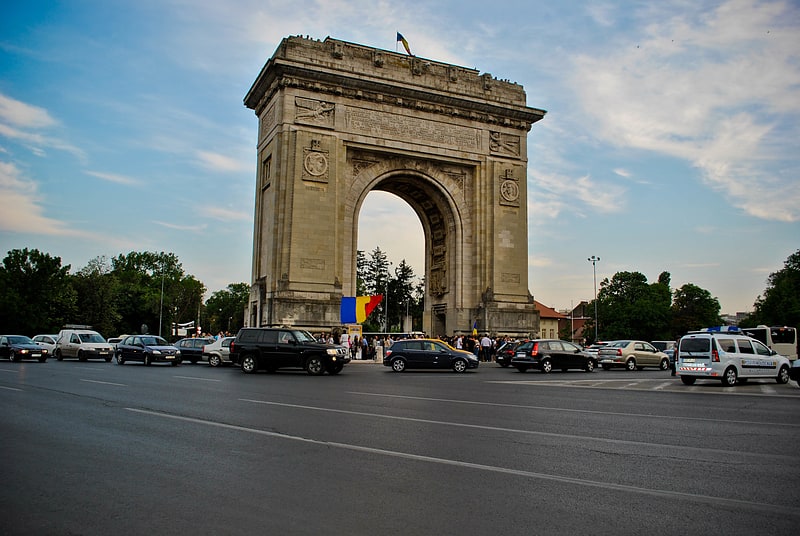
Grand granite war memorial archway. Arcul de Triumf is a triumphal arch located in the northern part of Bucharest, on the Kiseleff Road.
The first, wooden, triumphal arch was built hurriedly, after Romania gained its independence (1878), so that the victorious troops could march under it. Another arch with concrete skeleton and plaster exterior of elaborate sculptures and decoration designed by Petre Antonescu was built on the same site after World War I in 1922. The arch exterior, which had seriously decayed, was replaced in 1935 by the current much more sober Neoclassical design, more closely modelled in the Arc de Triomphe in Paris. The new arch, also designed by Petre Antonescu and executed in stone, was inaugurated on 1 December 1936.
The arch has a height of 27 metres. It has as its foundation a 25 x 11.50 metres rectangle. The sculptures with which the facades are decorated were created by famous Romanian sculptors such as Ion Jalea and Dimitrie Paciurea.
Presently, military parades are held beneath the arch each 1 December, with the occasion of Romania's national holiday.
Elisabeta Palace, the current residence of the Romanian Royal Family, is located near the Arch of Triumph, in Herăstrău Park.[13]
Address: Piata Arcul de Triumf, Bucharest (Sector 1)
Cișmigiu Gardens
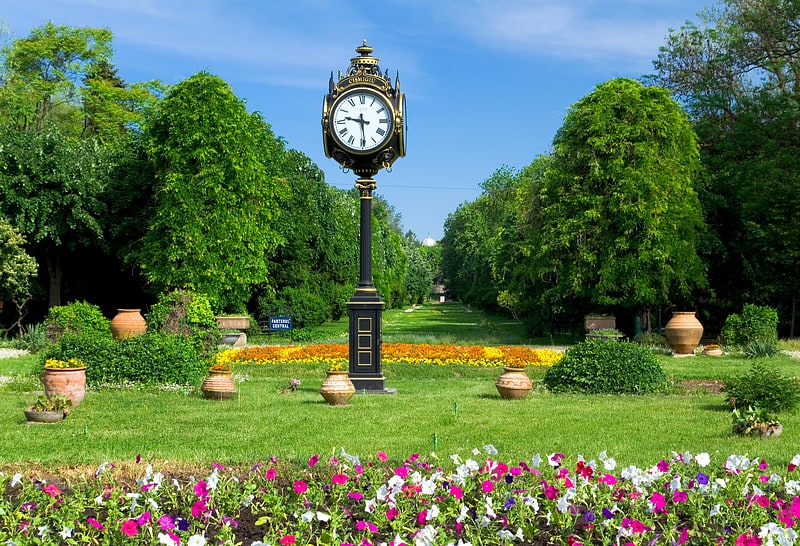
Also known as: Parcul Cișmigiu
Park in Bucharest, Romania. The Cișmigiu Gardens or Cișmigiu Park are a public park in the center of Bucharest, Romania, spanning areas on all sides of an artificial lake. The gardens' creation was an important moment in the history of Bucharest. They form the oldest and, at 14.6 hectares, the largest park in city's central area.
The main entrance is from Elisabeta Boulevard, in front of the General City Hall of Bucharest; there is another major entrance at the Știrbei Vodă Street, near the Crețulescu Palace. The southwestern corner of the park is adjacent to the prestigious Gheorghe Lazăr National College. The park attracts an average of 5,100 visitors on a weekend day.[14]
Address: Bd. Regina Elisabeta, 010105 București (Sector 1)
Victoria Palace

Also known as: Palatul Victoria
Palace in Bucharest, Romania. The Victoria Palace is a government building on the large Victory Square in Bucharest, housing the Prime Minister of Romania and his cabinet.
The Victory Palace was designed in 1937 to house the Foreign Ministry, and nearly complete in 1944. It was designed by architect Duiliu Marcu (1885–1966), who had designed many major buildings in 1920s and 30s Romania, including many major government projects in the 1930s and 40s. The Victory Palace is a stylised monumental classical design, with an arcaded ground level, a long colonnade of slim piers on the main front, and two recessed top floors. The facades were entirely clad in Carrara marble, with reliefs in the panels at either end, and there were generously decorated interiors.
The building suffered heavy damage in the 1944 Bombing of Bucharest in World War II. It then underwent significant restoration and reconstruction works, being reclad in travertine, without the reliefs and less ornate interiors, finally opening in 1952, housing the headquarters of Foreign Ministry and the Council of Ministers.
Following the Romanian Revolution, in 1990 it became the headquarters of the first government of post-communist Romania, a role it still fulfils, housing the office of the Prime Minister of Romania.
The palace was declared a historical monument in 2004.[15]
Palace of the National Military Circle
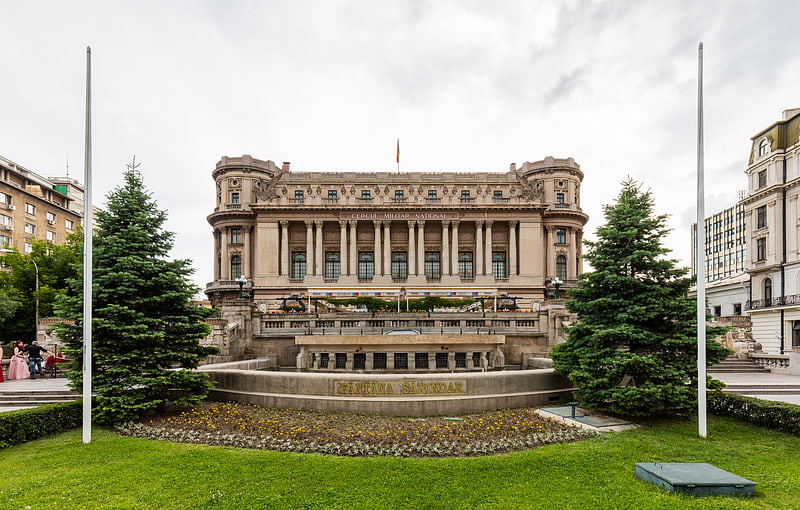
Also known as: Palatul Cercului Militar Național
The Palace of the National Military Circle, also known as the Officers' Circle Palace is located on Constantin Mile street in Bucharest, Romania. It was built in 1911, based on plans drawn by chief architect Dimitrie Maimarolu, using French neoclassical style. The beneficiary was the Officers' Circle of the Bucharest military garrison, which was founded in 1876.[16]
Curtea Veche
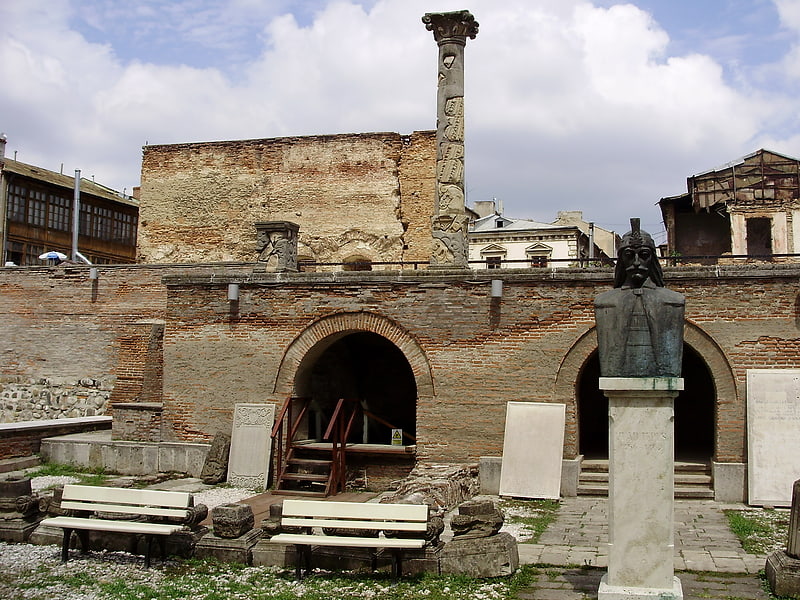
15th-century princely home, now a museum. Curtea Veche was built as a palace or residence during the rule of Vlad III Dracula in 1459. Archaeological excavations started in 1953, and now the site is operated by the Muzeul Municipiului București in the historic centre of Bucharest, Romania.[17]
Address: Strada Franceză 33, 030105 București (Sector 3)
Romexpo

Exhibition centre in Bucharest, Romania. Romexpo, also known as Romexpo Dome or Romexpo Town, is a large exhibition center and indoor arena in Bucharest, Romania. It is primarily used for exhibitions, concerts, and sporting events. The complex also hosts more than 140 other exhibits and trade shows every year. It is 303,234 square metres, houses 100,000 square metres under roof, spread throughout 11 pavilions.
It is close to other Bucharest landmarks, including the Bucharest World Trade Center, City Gate Towers, and the House of the Free Press.
In 2018, it covered an exhibition area of 143,000 square meters. There were over 142,000 participants, including 3,500 exhibiting companies from 45 countries.
In September 2020, the Chamber of Deputies passed a law to hand the area over to Chamber of Commerce and Industry, allowing a private investment to develop a roughly €3 billion real estate project on the land. Iulius Group plans a gigantic complex that will include 14 new buildings with various purposes: offices, residential, hotels, commercial spaces and museums, plus 12,000 parking spaces.[18]
Address: Bucharest, 65-67 Mărăști Boulevard
Kretzulescu Church
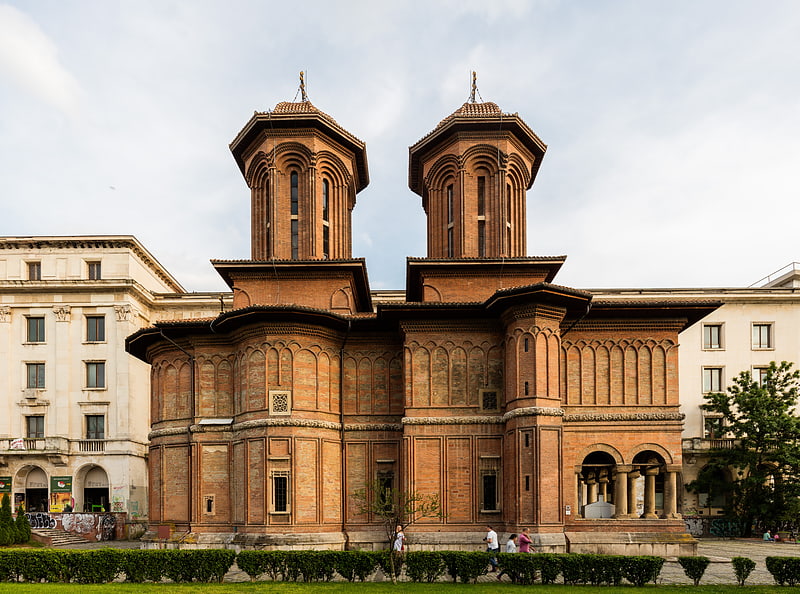
Also known as: Biserica Kretzulescu
Brick Orthodox church built in the 1720s. Kretzulescu Church is an Eastern Orthodox church in central Bucharest, Romania. Built in the Brâncovenesc style, it is located on Calea Victoriei, nr. 45A, at one of the corners of Revolution Square, next to the former Royal Palace.
The church was commissioned in 1720–1722 by the boyar Iordache Crețulescu and his wife Safta, a daughter of prince Constantin Brâncoveanu. Originally, the exterior was painted, but since the restoration work done in 1935–1936 (under the supervision of architect Ștefan Balș), the façade is made of brick. The frescoes on the porch date from the original structure, while the interior frescoes were painted by Gheorghe Tattarescu in 1859–1860.
The church, damaged during the 1940 Vrancea earthquake, was repaired in 1942–1943. In the early days of the communist regime, Kretzulescu Church was slated for demolition, but was saved due to efforts of architects such as Henriette Delavrancea-Gibory. More renovations took place after the Bucharest earthquake of 1977 and the Revolution of 1989. To the side of the church now stands a memorial bust of Corneliu Coposu.[19]
Address: Calea Victoriei 45, 010062 București (Sector 1)
Herăstrău Park
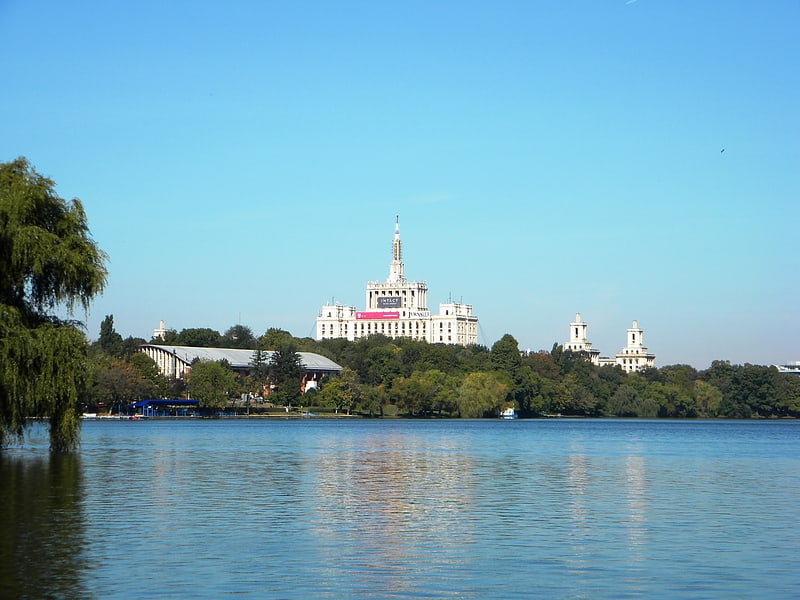
Also known as: Parcul Regele Mihai I al României
Large town park with lake and woodlands. King Michael I Park, formerly Herăstrău Park, is a large park on the northern side of Bucharest, Romania, around Lake Herăstrău, one of the lakes formed by the Colentina River.[20]
Address: 7-9 Șoseaua Nordului, Bucharest (Sector 1)
Muzeul Țăranului Român
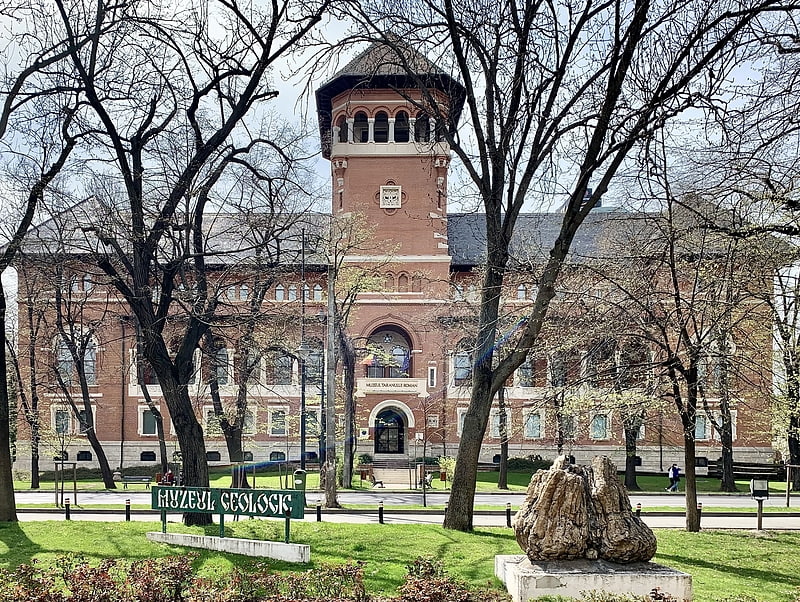
Also known as: Muzeul Național al Țăranului Român
National ethnographic and folk art museum. The National Museum of the Romanian Peasant is a museum in Bucharest, Romania, with a collection of textiles, icons, ceramics, and other artifacts of Romanian peasant life. One of Europe's leading museums of popular arts and traditions, it was designated "European Museum of the Year" for 1996.[21]
Address: Soseaua Kiseleff 3, Sector 1, Bucharest (Sector 1)
Bucharest Botanical Garden
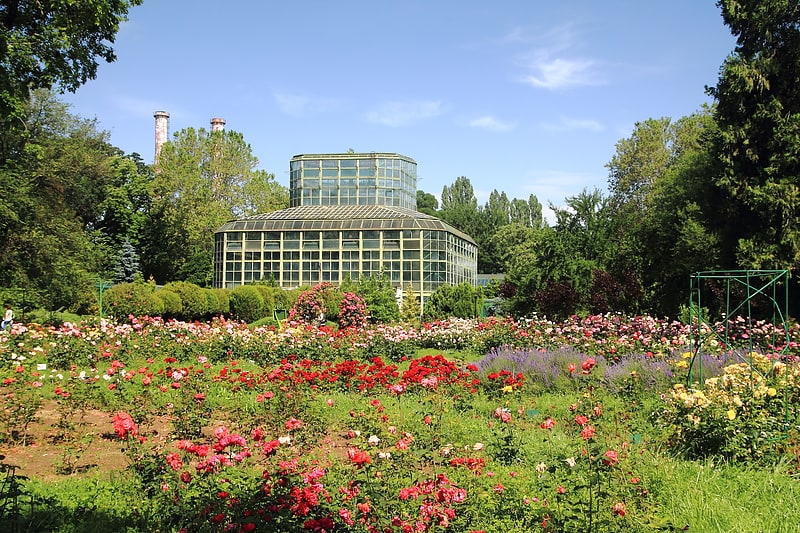
Also known as: Grădina Botanică din București
Botanical gardens with grand greenhouses. The Bucharest Botanical Garden, now named after its founder, Dimitrie Brândză, is located in the Cotroceni neighbourhood of Bucharest, Romania. It has a surface of 18.2 hectares, including 4,000 square metres of greenhouses, and has more than 10,000 species of plants.
The first botanical garden in Bucharest was founded in 1860 near the Faculty of Medicine by Carol Davila. The decree establishing the Botanical Garden was signed by Prince Alexandru Ioan Cuza on November 5 of that year. Its first director was the botanist Ulrich Hoffmann, followed six years later by Dimitrie Grecescu. The garden was eventually moved to its current location in 1884 by Dimitrie Brândză, a Romanian botanist, and Louis Fuchs, a Belgian landscape architect. The gardens were opened in 1891, when the building of the greenhouses finished. The garden was damaged during World War I, when it was used by the German occupation troops, and during World War II, when it was hit by Anglo-American bombardments.
In the Garden there is a Botanical Museum in a building of the Brâncovenesc style, located near the entrance gate, where more than 5,000 plant species are displayed, including 1,000 exotic plants.
The Old Greenhouse of the Botanical Garden was built between 1889 and 1891, along the lines of the Greenhouses of Liège, Belgium. In 1976 it was closed to the public, continuing to house only crop plants. The Pavilion was rehabilitated in 2011, being arranged as a tropical forest corner and containing species of several exotic plant families.[22]
Address: Șos. Cotroceni nr. 32, 060114 București (Sector 5)
Tineretului Park
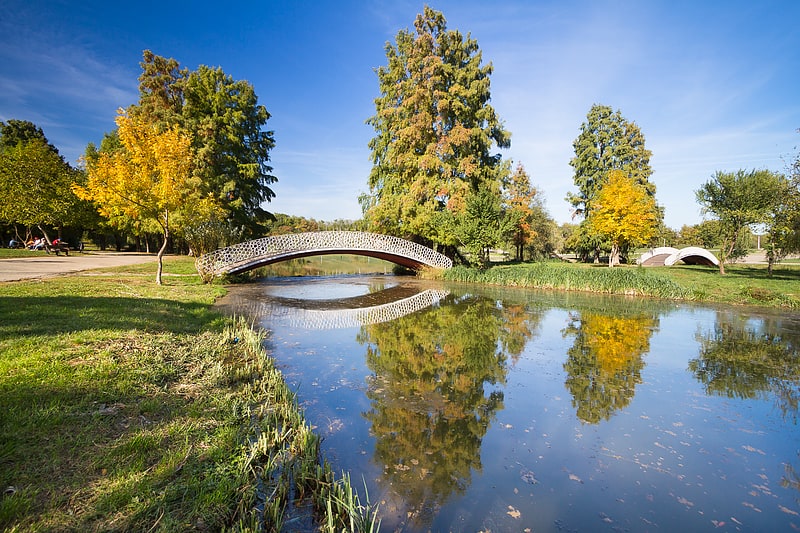
Also known as: Parcul Tineretului
Park with lake, cycling and sports complex. Tineretului Park is a large public park in southern Bucharest.[23]
Address: Bd. Tineretului, Bucharest (Sector 4)
Romanian Patriarchal Cathedral

Also known as: Catedrala Patriarhală din București
Monument in Romania. The Romanian Orthodox Patriarchal Cathedral is a functioning religious and civic landmark, on Dealul Mitropoliei, in Bucharest, Romania. It is located near the Palace of the Chamber of Deputies of the Patriarchate of the Romanian Orthodox Church. Since it is a working cathedral, it is the site of many religious holidays and observances that take place for those who follow the Orthodox Christian faith in Bucharest, including a Palm Sunday pilgrimage. The Orthodox Divine Liturgy at the cathedral is known for its a cappella choir, a common practice shared by all the Orthodox churches, in both their prayer services and liturgical rites. The Romanian Orthodox Patriarchal Cathedral is a designated Historical monument—Monument istoric of Romania.[24]
Address: Aleea Dealul Mitropoliei 2, 040163 București (Sector 4)
Observatory

The Bucharest Observatory is an astronomical observatory located at 21 Lascăr Catargiu Boulevard, Bucharest, Romania.
The observatory was built between 1908 and 1910, for Admiral Vasile Urseanu. It was equipped with a 150 mm diameter Zeiss telescope with a focal length of 2.7 meters; the telescope was the third largest in Romania at the time. Ion D. Berindey was the architect. It is Bucharest’s only observatory open to the public.
The Urseanu House is listed as a historic monument by Romania's Ministry of Culture and Religious Affairs.[25]
Address: 21, Blvd. Lascar Catargiu, Bucharest (Sector 1)
Royal Palace of Bucharest

Also known as: Palatul Regal din București
Building in Bucharest, Romania. The Royal Palace of Bucharest, known as Palace of the Republic between 1948 and 1990, is a monumental building situated in the capital of Romania, on Calea Victoriei. The Palace in its various incarnations served as official residence for the Kings of Romania until 1947, when the communist regime was installed after Michael I of Romania's forced abdication. Since 1950 the Palace hosts the National Museum of Art of Romania. The former Romanian royal family currently uses Elisabeta Palace as its official residence in Bucharest.
The Palace is the largest and most significant royal residence in the country, containing emblematic official spaces such as the Throne Hall, the Royal Dining Hall and the monumental Voivodes' Staircase. An equestrian statue of the first king of Romania, Carol I stands in the center of a large square in front of it, traditionally known as the "Palace Square"(Romanian: Piața Palatului), but renamed "Revolution Square" after the Romanian revolution of 1989.[26]
Address: Bucharest, 49–53 Calea Victoriei, 010063 Bucharest, sector 1
Stavropoleos Monastery

Also known as: Biserica Stavropoleos
Orthodox monastery founded in 1724. Stavropoleos Monastery, also known as Stavropoleos Church during the last century when the monastery was dissolved, is an Eastern Orthodox monastery for nuns in central Bucharest, Romania. Its church is built in Brâncovenesc style. The patrons of the church are St. Archangels Michael and Gabriel. The name Stavropoleos is the genitive case of Stavropolis. One of the monastery's constant interests is Byzantine music, expressed through its choir and the largest collection of Byzantine music books in Romania.[27]
Address: Strada Stavropoleos 4, 030167 București (Sector 3)
Cantacuzino Palace
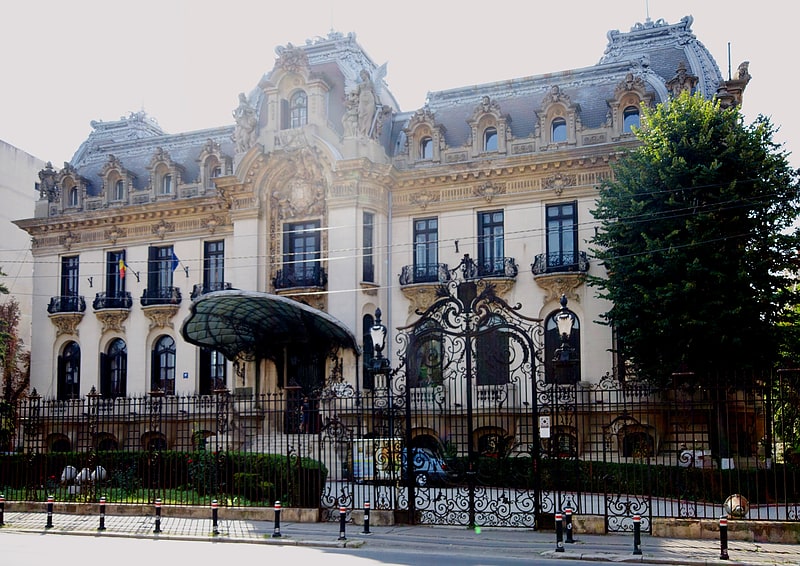
Also known as: Palatul Cantacuzino
Monument in Bucharest, Romania. Cantacuzino Palace is located on Calea Victoriei no. 141, Bucharest, Romania. It was built by architect Ion D. Berindey in the Beaux Arts style, having a few Rococo Revival rooms. Today it houses the George Enescu museum.[28]
Tomb of the Unknown Soldier
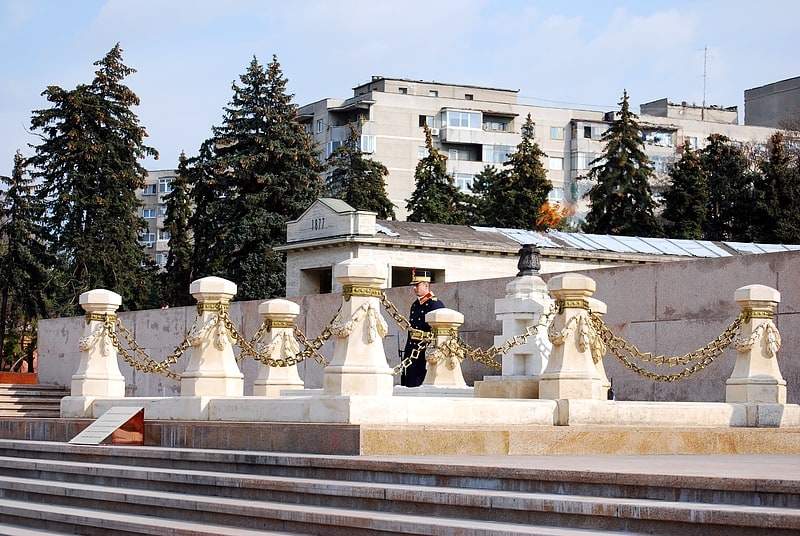
Also known as: Mormântul Ostașului Necunoscut
The Tomb of the Unknown Soldier is a monument located in Bucharest, Romania. Dedicated to the soldiers who died while fighting for Romania. It is one of many such national tombs.
It was built in 1923 to commemorate the Romanians who died during World War I.[29]
Address: Parcul Carol I, Bucharest (Sector 4)
Piața Unirii
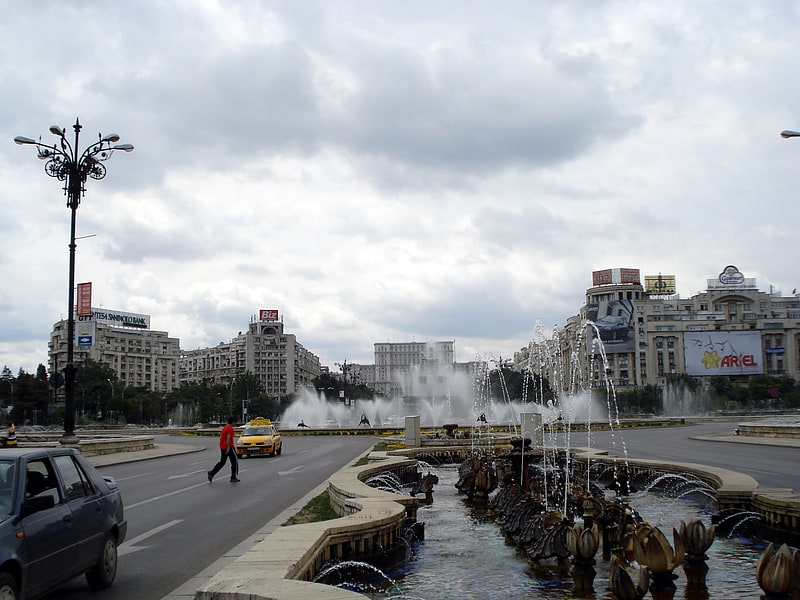
Piața Unirii is one of the largest squares in central Bucharest, Romania, located in the center of the city where Sectors 1, 2, 3, and 4 meet. Part of the Civic Centre, it is bisected by Unirii Boulevard, originally built during the Communist era as the Boulevard of the Victory of Socialism, and renamed after the Romanian Revolution.
The square is a significant transport hub, containing the Piața Unirii metro station and a major interchange for STB buses; there is also a tram terminal near the southwest corner. The Unirea Shopping Center, the Cocor department store and a large taxi rank are located on the east side of this square, while Hanul lui Manuc is on the north side, near the northeast corner. The centre of the square boasts a small park and fountains which are particularly popular with commuters and passers-by in the torrid summer months. There were plans to build the Romanian National Salvation Cathedral on the place of this park, but the idea proved technically impossible due to the busy underground environment and lack of popularity among local citizens and therefore the location was changed.
The square features a large Christmas tree erected every December.[30]
Antim Monastery
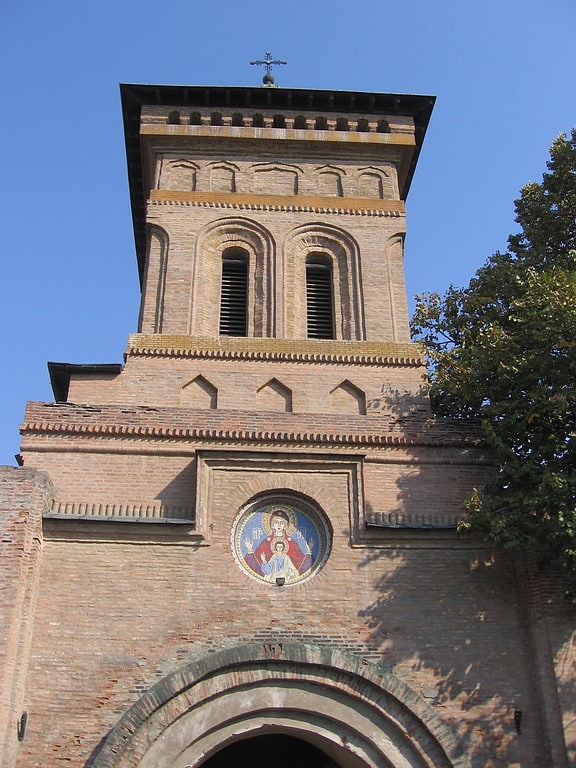
Also known as: Mănăstirea Antim
1700s Brâncovenesc monastery and museum. The Antim Monastery is located in Bucharest, Romania on Mitropolit Antim Ivireanu Street, no. 29. It was built between 1713 and 1715 by Saint Antim Ivireanu, at that time a Metropolitan Bishop of Wallachia. The buildings were restored by Patriarch Justinian Marina in the 1960s. As of 2005, there are 7 monks living in the Monastery. The monastery also hosts a museum with religious objects and facts about the life of Antim Ivireanu.
The Monastery is connected to the Legionnaires' rebellion and Bucharest pogrom. On January 22, 1941, led by Hieromonk Nicodem Ioniță, the monks of Antim armed themselves and, using explosives, blew up a synagogue on Antim Street. The numerous Jewish inhabitants of the neighborhood hid in terror. Some of the monks involved were graduates of the Cernica Seminary, a Legionary stronghold.
During the communist rule of Nicolae Ceaușescu, the government threatened demolition of the church and many other historic structures in Romania. A project organized by engineer Eugeniu Iordăchescu moved the church to a different nearby site and saved it in time.[31]
Address: Strada Mitropolit Antim Ivireanu 29, 040111 Bucharest (Sector 5)
Palace of Justice
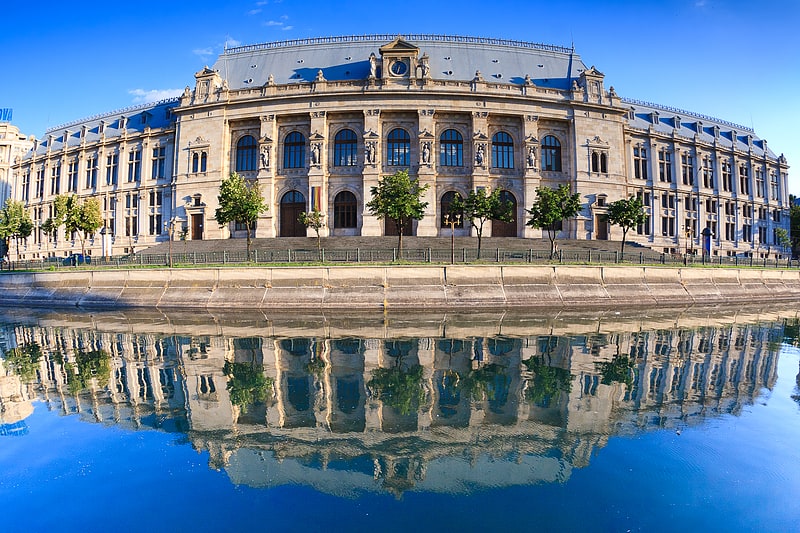
Also known as: Palatul de Justiție din București
Grand riverfront Neo-Renaissance palace. The Palace of Justice, located in Bucharest, Romania, was designed by the architects Albert Ballu and Ion Mincu and built between 1890 and 1895. The foundation stone was laid by King Carol I of Romania on October 7, 1890. The façade of the building is adorned with several statues representing allegories: Law, Justice, Justice, Truth, Force, and Prudence; the statues are the work of sculptors Carol Storck and Frederic Storck.
Located on the banks of the Dâmbovița River, the palace houses the Bucharest Court of Appeal, the Sector 5 Court, the National Union of Romanian Bars, and the Bucharest Bar. Its last major restoration was between 2003 and 2006.
The Palace has 690 rooms with a total area of 33,235 m2.[32]
Address: Splaiul Independenței nr. 5, sect. 4, Bucharest (Sector 5)
Revolution Square

Also known as: Piața Revoluției
Revolution Square is a square in central Bucharest, on Calea Victoriei. Known as Palace Square until 1989, it was renamed after the Romanian Revolution of December 1989. The former Royal Palace, the Athenaeum, the Athénée Palace Hotel, the University of Bucharest Library and the Memorial of Rebirth are located here. The square also houses the building of the former Central Committee of the Romanian Communist Party. In 1990, the building became the seat of the Senate and since 2006 it houses the Ministry of Interior and Administrative Reform.
Prior to 1948, an equestrian statue of King Carol I of Romania stood there. Created in 1930 by the Croatian sculptor Ivan Meštrović, the statue was destroyed in 1948 by the Communists, who never paid damages to the sculptor. In 2005, the Romanian Minister of Culture decided to recreate the destroyed statue from a model that was kept by Meštrović's family. In 2007, the Bucharest City Hall assigned the project to the sculptor Florin Codre, who is going to design an original statue of Carol inspired by Meštrović's model (most consider it a plagiarism).
In August 1968 and December 1989, the square was the site of two mass meetings which represented the apogee and the nadir of Ceaușescu's regime. Ceaușescu's speech of 21 August 1968 marked the highest point in Ceaușescu's popularity, when he openly condemned the Soviet invasion of Czechoslovakia and started pursuing a policy of independence from Kremlin. Ceaușescu's speech of 21 December 1989 was meant to emulate the 1968 assembly and presented by the official media as a "spontaneous movement of support for Ceaușescu", erupting into the popular revolt which led to the end of the regime.[33]
Mihai Vodă Monastery

Also known as: Mănăstirea Mihai Vodă
Orthodox church in Bucharest, Romania. The Mihai Vodă Monastery, founded by Mihai Viteazul, is one of the oldest buildings in Bucharest. It was built in 1591, surrounded by stone walls, similar to a fortress. The monastery buildings served multiple purposes over time such as residence of the country's leaders, military hospital, medical school and the site of the National Archives of Romania. The monastery was an important archeological site; inside the monastery yard used to be a Dacian archeological site, more than 3000 years old, where old pottery and other relics were found.
In 1813 Mihai Vodă Monastery was "one of the largest monasteries of Romania". Between 1908 and 1909, Cristofi Cerchez, head of architecture for the Ministry of Religious Affairs, supervised work on the State Archives at the Monastery.
At the time of the communist regime in 1985, the church building was moved on rails 285 metres east and hidden in its present location on Sapienței street, next to Splaiul Independenței street and Izvor Park. That was to make way for a civic centre. The medieval cloisters and ancillary buildings were demolished.
Mihai Vodă Monastery has been included into the List of historical monuments of Romania and has been classified under the code B-II-a-A-19644.[34]
Address: Strada Sapienței 4, 050131 București (Sector 5)
Lake Cișmigiu
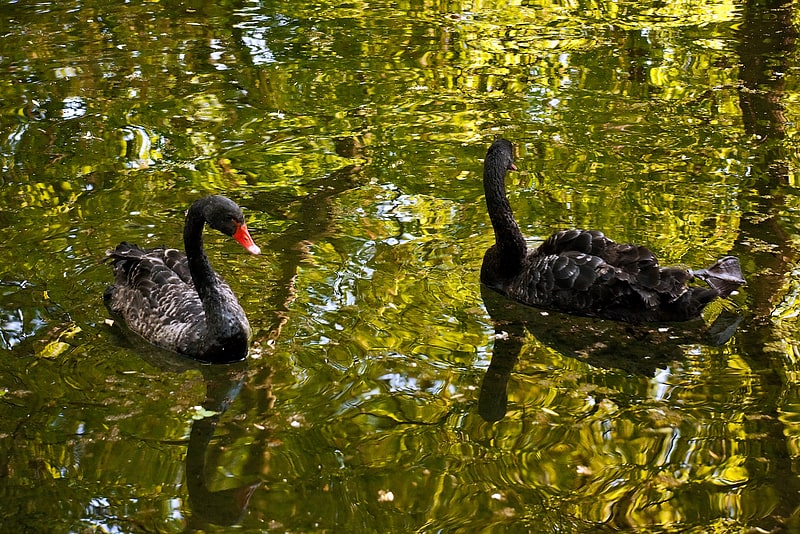
Also known as: Lacul Cișmigiu
Lake in Romania. Lake Cișmigiu is a lake in the center of Bucharest, Sector 1, in Cișmigiu Gardens. The lake has a surface of 29.500 m², a length of 1.3 km, a width of 50 meters and a depth of 1–2 meters. During winter the lake is dried artificially and a skate park is organized on the lake bed. Close to the Lake Cișmigiu in the Cișmigiu Gardens is the much smaller Lake Lebedelor, which is reserved for water birds.[35]